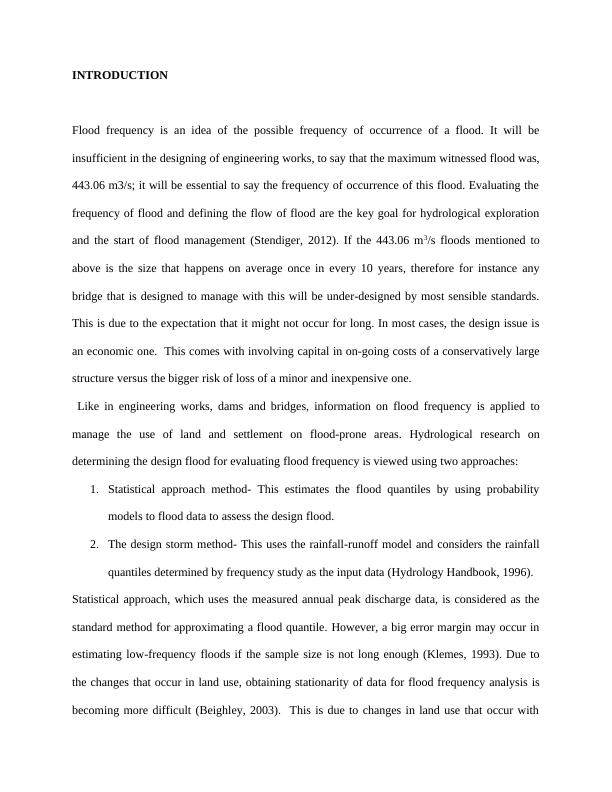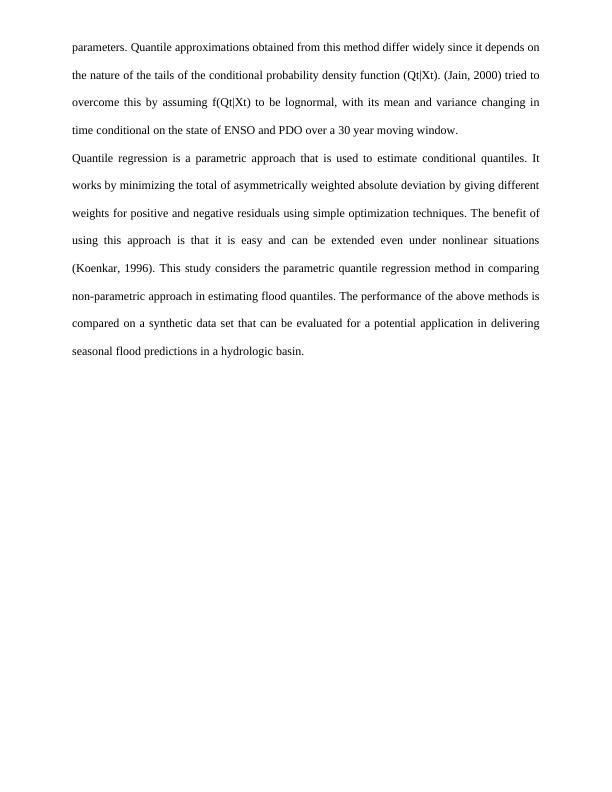Ask a question from expert
Unit 301013 Advanced Statistical Hydrology
19 Pages4482 Words152 Views
Western Sydney University
301013 Advanced Statistical Hydrology (301013)
Added on 2020-05-03
Unit 301013 Advanced Statistical Hydrology
Western Sydney University
301013 Advanced Statistical Hydrology (301013)
Added on 2020-05-03
BookmarkShareRelated Documents
INTRODUCTIONFlood frequency is an idea of the possible frequency of occurrence of a flood. It will beinsufficient in the designing of engineering works, to say that the maximum witnessed flood was,443.06 m3/s; it will be essential to say the frequency of occurrence of this flood. Evaluating thefrequency of flood and defining the flow of flood are the key goal for hydrological explorationand the start of flood management (Stendiger, 2012). If the 443.06 m3/s floods mentioned toabove is the size that happens on average once in every 10 years, therefore for instance anybridge that is designed to manage with this will be under-designed by most sensible standards.This is due to the expectation that it might not occur for long. In most cases, the design issue isan economic one. This comes with involving capital in on-going costs of a conservatively largestructure versus the bigger risk of loss of a minor and inexpensive one. Like in engineering works, dams and bridges, information on flood frequency is applied tomanage the use of land and settlement on flood-prone areas. Hydrological research ondetermining the design flood for evaluating flood frequency is viewed using two approaches: 1.Statistical approach method- This estimates the flood quantiles by using probabilitymodels to flood data to assess the design flood.2.The design storm method- This uses the rainfall-runoff model and considers the rainfallquantiles determined by frequency study as the input data (Hydrology Handbook, 1996).Statistical approach, which uses the measured annual peak discharge data, is considered as thestandard method for approximating a flood quantile. However, a big error margin may occur inestimating low-frequency floods if the sample size is not long enough (Klemes, 1993). Due tothe changes that occur in land use, obtaining stationarity of data for flood frequency analysis isbecoming more difficult (Beighley, 2003). This is due to changes in land use that occur with

urbanization affect the frequency of floods (Arche, 2010), studies are therefore required to beconducted to modify the past flood data to the present condition. According to (Halcrow GroupLimited, 2008) the change in land use affects the hydrological responses of watersheds.However, quantifying these changes is very hard. Even if flood data are available for the site ofinterest, regulating the flood data measured in the past period to the present land use is difficultand limits the calculation of correct flood quantiles.The design storm approach is used in estimating the flood quantiles by applying rainfall quantilesobtained from rainfall frequency analysis to the rainfall-runoff model. This method requires threebasic assumptions which include the selection of design rainfall hyetograph (rainfall duration andtime distribution), selection of antecedent soil moisture conditions before the storm occurs, andthe equality of the return periods between the rainfall quantiles and computed flood quantiles.The assumption that the return periods are equal between rainfall quantiles and simulated floodquantiles is not sometimes satisfactory (Adams, 1986). Many researchers have found out that thedesign storm method can only produce acceptable peak discharge for a given return period if thismethod is properly used (Guo, 2001). Statistical approach in obtaining flood frequency analysis is carried out using parametricmethods in which a statistical distribution is used to fit the available data for frequency analysisand estimation of rare events. These are normal (N), two parameter log-normal (LN2), threeparameter log-normal (LN3), two parameter gamma (G2), Pearson type III (P3), log-Pearsontype III (LP3) and Gumbel extreme value type I (G). These methods have been successfullyapplied in many cases despite some disadvantages because not fitting to the experimental datavery well, or diverging from the extreme tails used earlier. Other conditions that arouse problemswith the parametric methods are involving the difficulties of approximation of the bestparameters for these approaches particularly for skewed data. The following are ways of describing flood frequency using statistical probability.

1.Assigning the return periods to particular floods has been traditional way. It is not helpfulin trying to explain its meaning to the public. One example of a return period is when aflood has a 1 % probability of occurring in a certain year and is thus described as a 100-year flood event. This suggests a common but wrong notion that there should be aninterval of 100 years between events. The probability of having two 100-year floodswithin 10 years is nearly 10 %. 2.Another one is the annual exceedance probability (AEP). This is the probability that aspecific flood size will occur in one given year. As with example above, the 100-yearflood will have an AEP of 1 %. Describing the probability using this approach is betteras compared to the first one.3.The probable maximum flood (PMF) concept that is mostly applied in engineering. Thisis also similar to the two methods used above, and it often uses the 100-year per 1 %probability, since most designs are based on this. It is unlikely that PMF implies a lowerprobability than 1 %, and values as low as 0.1 % used in its applications. Trying toderive a PMF is very risky unless there is a very long record. Q can used to define the flood variable of interest, the annual maximum flow, in which the flowQ exceeds a threshold q*. The inference of the pth quantile, Qpt (quantile) of Q, for year t,conditional on some set of m climatic indices (or other predictors), Xt = [xt x2t _ _ _ xmt], is ofinterest. To do this, an estimate of the conditional probability density function f(Qt|Xt), or theconditional distribution function F(Qt|Xt) from the historical data {Qt, Xt, t = 1. . .n}:Fp(Qt∨Xt)=∫−∞Qptf(Qt|Xt)dQ=pEquation 1aQpt=Fp−1(Qt∨Xt)Equation 1bThe conventional way to estimate the conditional distribution function F (Qt|Xt) assums that thejoint probability density function f(Qt, Xt) follows a certain distribution to estimate its

parameters. Quantile approximations obtained from this method differ widely since it depends onthe nature of the tails of the conditional probability density function (Qt|Xt). (Jain, 2000) tried toovercome this by assuming f(Qt|Xt) to be lognormal, with its mean and variance changing intime conditional on the state of ENSO and PDO over a 30 year moving window.Quantile regression is a parametric approach that is used to estimate conditional quantiles. Itworks by minimizing the total of asymmetrically weighted absolute deviation by giving differentweights for positive and negative residuals using simple optimization techniques. The benefit ofusing this approach is that it is easy and can be extended even under nonlinear situations(Koenkar, 1996). This study considers the parametric quantile regression method in comparingnon-parametric approach in estimating flood quantiles. The performance of the above methods iscompared on a synthetic data set that can be evaluated for a potential application in deliveringseasonal flood predictions in a hydrologic basin.

End of preview
Want to access all the pages? Upload your documents or become a member.
Related Documents
Statistical Hydrology | Assessment - 1lg...
|20
|3102
|141
Statistical Hydrology Case Study 2022lg...
|21
|3516
|23
IFD curves and Design Storm for Sunshine Coast Council (SCC) - Doclg...
|11
|1893
|217
Imputation of Hydrological Datalg...
|8
|1417
|23
Surface Water Hydrology - Assignment PDFlg...
|34
|746
|93
Homogeneity Analysis of Rainfall Time serieslg...
|8
|1264
|77